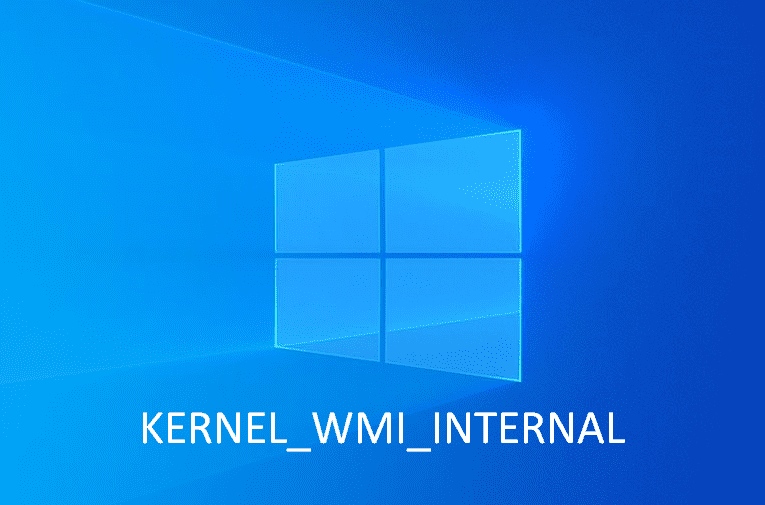Blue screen errors, one kind of system failure, are often hard to deal with and arise due to software or hardware corruption. Some of them get easily fixed with a simple restart or basic workarounds when some rare ones are pretty troublesome. KERNEL_WMI_INTERNAL is one of the hardly seen BSOD that a normal Windows 10 user conflicts. This error comes with bug check code 0x0000014A which mainly points out that the internal kernel WMI subsystem has encountered a fatal error. WMI mainly relates to scripts that are used to manage Windows 10 both locally and remotely.
KERNEL WMI INTERNAL blue screen error forces the system to crash abnormally. To lessen the aftereffects of such crashes, Windows 10 machine restarts periodically. Though these frequent restarts meant to save the critical data from permanent damage, the system ends up being a real mess. On top of that, you barely know what type of solutions will fix the issue since the error message doesn’t confirm the real cause. However, outdated OS, corrupted system files, virus attack, bad RAM, and software conflicts found to trigger blue screen errors in general.
Table of Contents
KERNEL_WMI_INTERNAL
Here is how to fix KERNEL_WMI_INTERNAL Blue Screen Error in Windows 10 –
1] Prevent Windows 10 from the random restart
When Windows 10 PC encounters any unexpected system crash like BSOD, Windows boot itself time and again. Since this all happens without any prior notice, some of the information from ongoing processes may go missing. Though these reboots save the system from permanent data loss or other damages, you hardly get enough scope to access the PC and apply workarounds. Hence, making the device stable moreover usable is the primary requirement before you start struggling to deploy any resolutions. To do so –
- Press – Windows + S.
- In the search bar, insert – advanced system settings.
- Hit – Enter.
- When System Properties appears, click Settings located under Startup and Recovery.
- Uncheck the box set before Automatically restart.
- Click – OK.
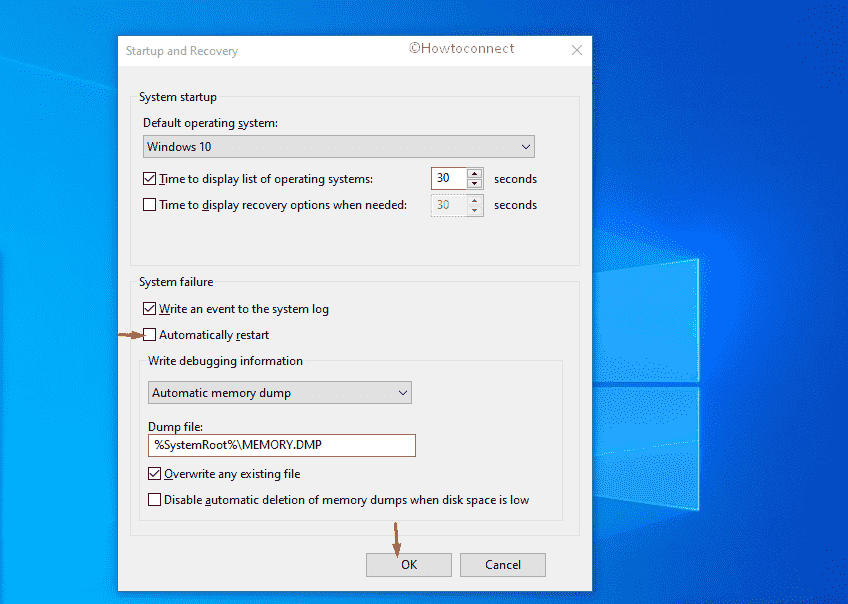
2] Start Safe Mode with Networking
Safe mode is mostly used to troubleshoot critical Windows 10 errors especially when the fatal code doesn’t let you access the PC. If blue screen error evolves from third-party software programs or services, safe mode will be great as this startup narrows down the number of non-essential programs. Along with unnecessary programs and services, no third-party programs will be available in this startup.
As Safe Mode lets Windows 10 start with limited programs, drivers, and services, any problem that evolved from third-party ones will be resolved immediately. If not, you will at least have an environment where you can deploy different workarounds to fix KERNEL_WMI_INTERNAL. For some workaround, the system may require internet, therefore Safe mode with networking will be a better choice as it keeps network drivers and services activate.
- Press – Windows key.
- Type in – advanced startup.
- Hit – Enter.
- From the right pane, click – Restart now.
- Once the system powers up, select Troubleshoot => Advanced options => Startup Settings in sequence.
- From next screen, click – Restart.
- When the system starts, either press 5 or f5 key to boot Safe Mode with Networking.
3] Remove viruses from your computer
Malware is a strongly coded program that mostly stays in disguise in spam emails, hacked websites, or USB drives. Once you click their link or file, they break down your security layer to affect the system. There are various kinds of malware you can come across but not all of them have the same characteristics. When a virus gets entrance, it starts infecting system files or the system areas of a computer or network router’s hard drive. The procedure keeps going unless you stop them immediately and clean the threats.
Some viruses are harmless, others may steal personal information, damage as well as destroy data files. To keep the system safe from any vulnerable threat, you need to strengthen the security shield so that, these viruses fail to get through. Windows Security is the latest inclusion in Microsoft’s shield mechanism that can give tough competition to any third-party anti-virus program. This default program of Windows 10 provides real-time antivirus protection against any kind of malware. Let’s do a virus scan with this utility and see if any malware is causing KERNEL_WMI_INTERNAL.
- Click the search icon present on the taskbar.
- Type in – Virus & threat protection.
- Hit – Enter.
- From the right overlay, click – Scan options.
- Select the radio button set before Full scan.
- Click – Scan now.
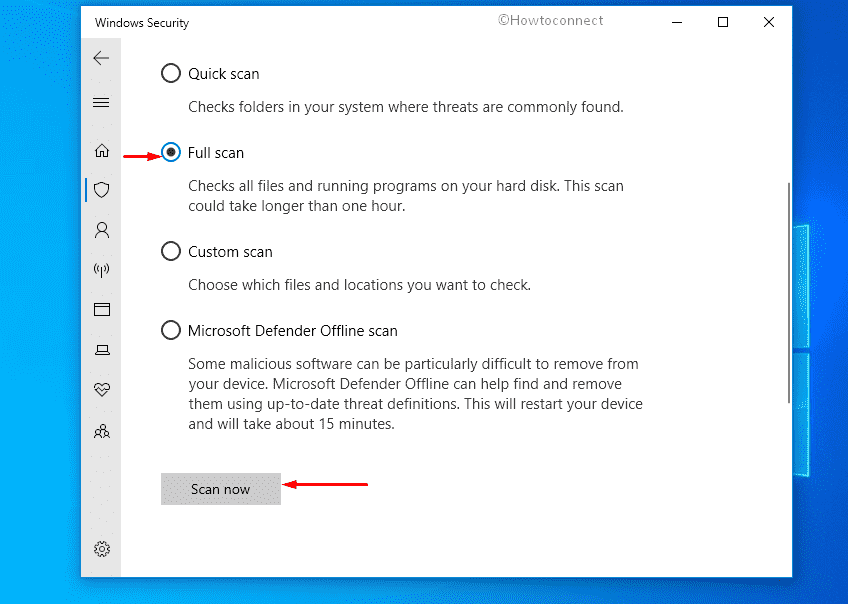
- Let Windows Security scan the full system without any interruption.
- If any malware is found, hit – Clean Threat.
- After that, click Remove and then Start actions.
- Reboot Windows 10.
4] Uninstall faulty Windows update to fix KERNEL_WMI_INTERNAL
Microsoft keeps releasing updates for Windows 10 through patches, insider builds quite regularly. With the default settings, Windows 10 receives these updates automatically if the system is connected with active internet. Unfortunately, the system often ends up getting broken installation files furthermore some updates are buggy themselves. When these faulty files get installed, Windows starts showing abnormal behavior and leads to several errors like KERNEL_WMI_INTERNAL.
Nevertheless, Microsoft provides fixes for the buggy update in the succeeding patch; that may take time. To fix any issue caused by the recent update, uninstall the same right away. Follow the below steps to remove the defective patch –
- Press – Windows + Q.
- Type in – view update history.
- Hit – Enter.
- Click the link – Uninstall updates.
- Scroll down to reach the Microsoft Windows section.
- Select the KB number you received lately.
- Click Uninstall from the top ribbon.
- Comply with on-screen instructions to complete the removal process.
- Restart the device.
5] Resolve and recover system elements
System components play a great role in assisting programs so that the Windows 10 device runs smoothly. If any of the elements becomes corrupted or goes missing, KERNEL_WMI_INTERNAL blue screen may evolve. Generally, such components get affected due to software conflict, sudden power surges, or malware infections.
Sometimes faulty Windows update and driver collision erase a few of them including .DLL files. As a result, the items become unreadable which later leads to unexpected system failures. Fortunately, Windows 10 has a built-in utility named System File Checker that resolves any corruption related to system components moreover recovers the missing ones. To run this utility, follow the below guidelines –
- Press – Windows + R.
- In the dialog box, put – cmd.exe.
- Press – Ctrl + Shift + Enter.
- To approve User Account Control, click – Yes.
- In the black pane, insert –
Sfc /scannow. - Hit – Enter.
- When the scanning process ends, review the report.
- If the utility fixed the existing corruption, close Command Prompt and restart the device.
- Or else, execute
DISM /Online /Cleanup-Image /RestoreHealthin the same pane. - Let the scanning process complete.
- After that, again run sfc command.
- This time, System File Checker should fix the corruption.
6] Check for faulty Device Drivers to resolve KERNEL_WMI_INTERNAL
If the device drivers don’t go with your system configuration, the stability of Windows 10 deteriorates furthermore it loses some functionality. A bad driver is largely responsible to bring forth KERNEL_WMI_INTERNAL BSOD error in Windows 10 as well. To make the device drivers compatible, you might need to update the same, or sometimes rolling back is needed. If you still get a blue screen error after doing so, there is a high chance that you couldn’t correct the faulty driver yet.
Sometimes the faulty driver doesn’t show up on the list or acts as a false positive, that is the reason, you overlook the same. Therefore, what you need to find out first is the actual bad driver that is triggering the blue screen error. For this purpose, Windows 10 offers a utility named Driver Verifier which verifies each driver installed on the system to find out the real culprit. Here is how you can use the tool –
- Press – Windows key.
- Type in – verifier.
- Hit – Enter.
- Give consent to User Account Control by clicking – Yes.
- Select the radio button of Create custom settings (for code developers).
- Click – Next.

- Select all checkboxes leaving out DDI compliance checking and Randomized low resources simulation unchecked.
- Hit – Next.
- Opt for – Select driver names from a list.
- Click – Next.
- Select the drivers whose provider is not Microsoft Corporation.
- Hit – Finish.
Oftentimes, Driver Verifier doesn’t get activated after the first attempt. Hence, you need to make sure the utility is running before proceeding further. To do so –
- Click the search icon from the taskbar.
- Write down – cmd.
- Press – Ctrl + Shift + Enter.
- To allow User Account Control, click – Yes.
- Insert verifier /querysettings in the Command Prompt.
- Hit – Enter key.
- If Driver Verifier is running, you will see a list of drivers now.
- If the system doesn’t return the list, perform the steps from the above segments once again.
After being sure that Driver Verifier is active, imitate the below steps –
- Restart Windows device.
- After signing back in, keep using the computer normally.
- Wait for the system to bring forth the BSOD. It may take a maximum of 36 hours.
- If you want to force the system, perform the task that was giving rise to the BSOD earlier.
- Once the error becomes visible, the utility will reveal the troublesome driver’s name on the screen.
- Reinstall the driver.
- Reboot Window 10 to make the changes effective.
7] Perform Clean Boot
Clean boot is a convenient method that helps to resolve critical Windows 10 issues by detecting a problematic program and service. This mode allows a few numbers of applications to be loaded at startup in order to smoothen the troubleshooting process. It’s almost similar to Safe mode only differs in the action of carrying out tests and diagnoses. To clean start Windows 10 and detect the faulty service or program, follow the steps given below –
- Press – Windows + S.
- Type in – msconfig.
- Hit – Enter.
- Shift to Services tab.
- Tick the checkbox set before Hide all Microsoft services.
- From the available services, keep the upper half selected and deselect the lower half.
- Hit – OK.
- From the next prompt, click – Restart.
- When the system powers up, check whether KERNEL_WMI_INTERNAL still exists.
- If the blue screen error shows up in this state, one of the selected services is at fault. To determine which one is problematic, keep one service selected at a time and find out the real culprit.
- If the system doesn’t bring forth the BSOD, repeat steps 1 through 5 first. This time, keep the lower half selected and deselect the services of the upper half.
- Click OK followed by Restart.
- Follow steps 9-10.
- If any of the services are found to be guilty, contact the manufacture’s to know whether it can be resolved.
- In case no service is causing the BSOD, check startup programs for any inconvenience.
- Open System Configuration and move to the Startup tab.
- Click – Open Task Manager.
- Disable one program at a time.
- Repeat steps 4 to 13.
- Similarly, disable other programs one after another and check whether a particular program is conflicting with any service.
- When you get the faulty one, uninstall the program.
- After fixing BSOD, you can install it back.
8] Uninstall unwanted applications to avoid conflict
There are thousands of applications available on the web and most of them help in executing tasks smoothly and in a faster mean. Though Windows 10 comes with a decent number of pre-installed programs, the system needs some more to carry out specific and advanced tasks. Since all applications are not available in the Microsoft Store, you may end up installing from several websites. Unfortunately, not all websites are trustworthy and may infuse bugs through setup files.
Some applications are faulty themselves and come with threats that cause additional damage to the system later. Besides, too many programs with similar congruence often get engaged in conflict with each other and end up affecting system components. During such collisions, some of the essential system element goes missing which later give rise to several error codes. To avoid such a situation, avoid downloading software from untrustworthy websites. Also, uninstall the apps you hardly use and likely to create a collision.
- Press – Windows + X.
- Select – Apps and Features.
- From the right-pane of appearing settings page, find the applications you want to remove.
- Select the same and click – Uninstall.
- To confirm the action, again hit – Uninstall.
- Comply with further instructions if any.
- Similarly, uninstall all unnecessary applications.
- Once you are done, restart the device.
9] Reconnect external USB peripherals to fix KERNEL_WMI_INTERNAL
Many Windows 10 users claimed that they started conflicting a blue screen error after connecting an external peripheral. This is quite frustrating as accessories like a mouse, keyboard, speaker, or even a printer are a dire need to make the day-to-day tasks easier. The connection between these hardware devices and blue screen errors is still unknown but it can be a faulty USB adapter. But not to worry much because a temporary breakdown most of the time fixes KERNEL_WMI_INTERNAL and other issues if it’s the real cause.
If you don’t know which device is actually causing the fatal code, unplug all accessories connected through USB. After that, reboot the PC and check if the blue screen error appears anymore. If not, you can be sure that any of the external devices is the actual culprit. In that case, plug back in the devices but one at a time and keep checking if any particular one is giving rise to BSOD.
10] Free up disk space
When your system runs out of free space, the operational speed degrades moreover the OS fails to perform some of the tasks. This often leads to KERNEL_WMI_INTERNAL and some other unexpected errors in Windows 10. Therefore, it’s necessary to keep enough free space in local disks. Without deleting any of your files, you can free up a good amount of space. To do so, Disk cleanup utility comes handy.
With each execution of a task, the system produces temporary files that become useless after a certain period of time. These items take over the same space as the original one. If you don’t clean them regularly, they end up occupying huge disk space furthermore make the system sluggish a bit. Disk cleanup is pretty helpful to clean up all temp files along with cache, old update files, and others. Here is how to run the tool –
- Press – Windows + Q.
- Type – cleanmgr.
- Hit – Enter.
- When Driver selection pop-up shows up, click – OK.
- From the next wizard, hit – Clean up system files.
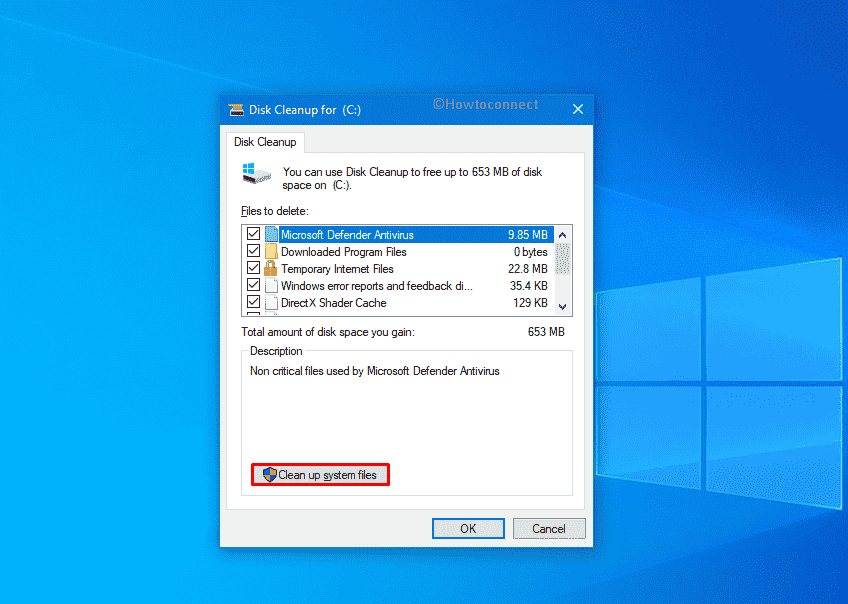
- Click – OK.
- Check all the boxes lying under Files to delete section.
- Click – OK.
- To confirm the process, hit – Delete files.
- When the cleaning process ends, reboot the device.
11] Scan hard disk for error to fix KERNEL_WMI_INTERNAL
A faulty and corrupted hard disk is yet another prime reason to cause KERNEL_WMI_INTERNAL blue Screen error in Windows 10. Hard disk is considered the soul part of any system as it is the permanent data storage. After prolonged use, the disk often found to form bad sectors in it. As a result, the system fails to perform some operation and ends up bringing forth unexpected error codes.
There are two types of bad areas that can form in a hard disk. One is known as hard or physical error and the second one is soft or logical error. The first one happens due to physical damage while the latter occurs due to a sudden power outage or forcibly pulling a plug from the device or software-related issues. If the hard disk is physically damaged, you will have to change the same. In case of software-related error, run Chkdsk command to fix existing corruption.
- Press – Windows key.
- Type in – cmd.exe.
- Right-click on Command Prompt and choose – Run as administrator.
- Copy
chkdsk C: /f /r /xand paste it at the base of the winking cursor. - Hit – Enter.
- Don’t interrupt the process in between and wait patiently.
- Review the diagnosis report.
- If the issue is fixed, reboot the device.
- Or else, follow the instructions that the report suggests.
12] Make sure Windows 10 is running the latest build
Troubleshooting a blue screen error is pretty irksome as most of them don’t have a fixed reason of origin. If you are still struggling to fix KERNEL_WMI_INTERNAL, updating Windows 10 to the latest build may work like a tweak. This happens because Microsoft keeps reviewing users’ complaints thoroughly and provides fixes for those issues through updates. When you install those updates, some of the error gets fixed automatically.
Microsoft rolls out cumulative patches quite regularly and most of them include modifications in their tool, UI management, security improvements, and bug fixes. Usually, Windows 10 devices get these patches automatically once they become available. But for that, the device should be connected to an unmetered data connection, and also automatic update option should remain enabled. However, you can check for available updates manually too. The guidelines are as follows –
- Press – Windows + I.
- Click – Update & Security.
- From the right-hand side, select – Check for updates.
- If the system gets any newer patch, hit – Download
- After completion of the downloading process, click – Install now.
- Finally, Hit – Restart now.
13] Test your RAM
RAM issues are largely responsible to cause any blue screen error in Windows 10. This memory stick is not permanent data storage and includes temporary files that the system produces after the execution of every single task. When bad sectors form in it, the system starts performing slower moreover sluggish. Also, unexpected errors rise up that is hard to recover.
Generally, memory issues occur due to overheating, sudden power surges, or physical damage. Though a critical bad RAM demands a full replacement of the unit, other minor issues can be fixed. To find out RAM issues, here are the steps to follow –
- Open Run dialog box.
- In the text bar, type in – mdsched.exe.
- Click – OK.
- Pick the option – Restart now and check for problems (Recommended).
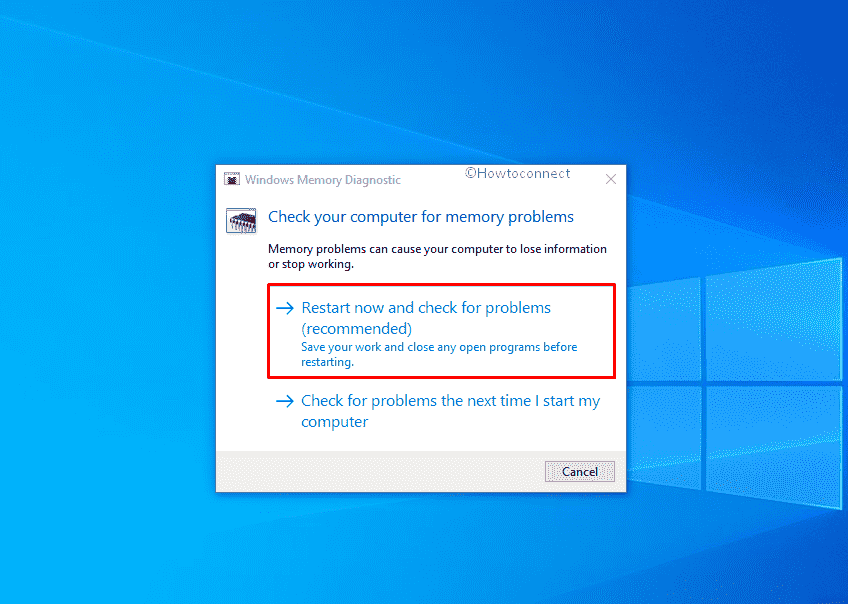
- Don’t interrupt the process in between and let the Memory diagnostic tool detect related issues.
- Windows 10 will restart normally once the test gets completely over.
- Open diagnosis report from the notification area.
- Review the report and take further steps accordingly.
14] Disable Fast boot to break down BSOD loop
To lessen the time Windows 10 takes to start, Fast boot collects all the necessary information from an ongoing session and carries forward the same. It’s a built-in feature of Windows and comes pre-enabled in the Operating System unless you override the settings. This might be the cause why the blue screen error KERNEL_WMI_INTERNAL keeps appearing. To prevent the system from carrying over the existing issue, disabling fast boot is necessary.
- Right-click the battery icon from system tray.
- Choose – Power Options.
- From the left sidebar of the appearing window, click – Choose what the power button do.
- Hit – Change settings that are currently unavailable.
- Uncheck the box set before Turn on fast startup (recommended).
- Click – Save Changes.
15] Update your computer’s BIOS to fix KERNEL_WMI_INTERNAL
BIOS is the initial firmware that starts when you switch on your Windows device. The main work of this is to provide runtime services for Windows 10 and programs installed on the device. When this BIOS of Windows leaves outdated, KERNEL_WMI_INTERNAL blue screen error may evolve. To update the firmware, follow the way –
- Press – Windows + S.
- Type in – msinfo32.
- Hit – Enter.
- Check the info present beside BIOS Version/Date.
- Note down the same.
- Close System Information window.
- Open a web browser you prefer.
- Browse the makers’ website of your BIOS.
- Look for the most current as well as the compatible version of BIOS using the previous info got.
- Download the setup file.
- Visit the directory where the system stores downloaded items.
- Double-click the downloaded exe file.
- Follow on-screen instructions to complete the installation process.
- In the end, reboot the device.
16] Go back to a previous error-free state
Abnormal changes in Windows often contradict with the registry and ends up causing KERNEL_WMI_INTERNAL. In such a case, undo the changes by loading back the previous state to get rid of this error code. To serve the purpose, Windows has a built-in utility knows as System restore. Run the tool following the below steps –
- Write down – rstrui in Windows search.
- Hit – Enter.
- When System Restore wizard appears, click – Next.
- Opt for a restore point available there.
- Click – Scan for affected programs.
- Select the applications you want to wipe out.
- Go back to System Restore wizard.
- Click – Next.
- To start restoring process, hit – Finish.
17] Start afresh with clean Windows to resolve KERNEL_WMI_INTERNAL
A clean install is the last resort to try out in case all workarounds from the above fail to fix KERNEL_WMI_INTERNAL. Doing so will overwrite all content present on the hard disk to remove the current OS and user files. Furthermore, you can start with a freshly installed OS. Here is how to proceed –
- Visit Software Download webpage of Microsoft.
- Click – Download tool now.
- Double-click the downloaded item.
- To allow User Account Control, click – Yes.
- When setup wizard turns up, click – Accept.
- Select – Create installation media (USB flash drive, DVD, or ISO file) for another PC.
- Hit – Next.
- Check whether the Language, Edition, and Architecture are set correctly.
- Click – Next.
- Choose – ISO file.
- Hit – Next.
- Select a location where you want to save the setup file.
- Click – Save.
- After that, hit – Finish.
- Visit the directory where you saved the file.
- Double-click the setup file.
- Comply with on-screen guidelines to complete the installation process.
Methods list
1] Prevent Windows 10 from the random restart
2] Start Safe Mode with Networking
3] Remove viruses from your computer
4] Uninstall faulty Windows update
5] Resolve and recover system elements
6] Check for faulty Device Drivers
7] Perform Clean Boot
8] Uninstall unwanted applications to avoid conflict
9] Reconnect external USB peripherals
10] Free up disk space
11] Scan hard disk for error
12] Make sure Windows 10 is running the latest build
13] Test your RAM
14] Disable Fast boot to break down BSOD loop
15] Update your computer’s BIOS
16] Go back to a previous error-free state
17] Start afresh with clean Windows
That’s all!!
